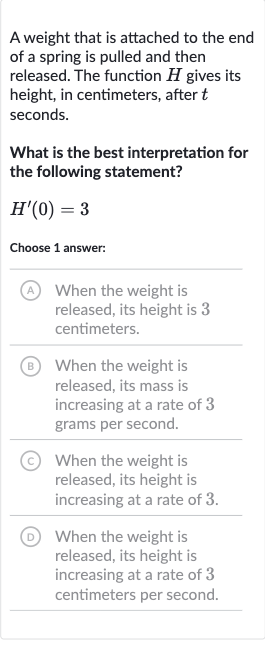AI tutor
Welcome to Bytelearn!
Let’s check out your problem:

A weight that is attached to the end of a spring is pulled and then released. The function gives its height, in centimeters, after seconds.What is the best interpretation for the following statement?Choose answer:(A) When the weight is released, its height is centimeters.(B) When the weight is released, its mass is increasing at a rate of grams per second.(C) When the weight is released, its height is increasing at a rate of .(D) When the weight is released, its height is increasing at a rate of centimeters per second.
Full solution
Q. A weight that is attached to the end of a spring is pulled and then released. The function gives its height, in centimeters, after seconds.What is the best interpretation for the following statement?Choose answer:(A) When the weight is released, its height is centimeters.(B) When the weight is released, its mass is increasing at a rate of grams per second.(C) When the weight is released, its height is increasing at a rate of .(D) When the weight is released, its height is increasing at a rate of centimeters per second.
- Rate of Change Interpretation: represents the rate of change of the height of the weight with respect to time. So, means that at time , the rate of change of height is .
- Unit Conversion: Since the unit of height is given in centimeters and time is in seconds, the rate of change of height, , is in centimeters per second.
- Height Increase Rate: The correct interpretation of is that when the weight is released, its height is increasing at a rate of centimeters per second.
